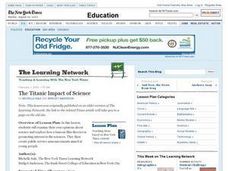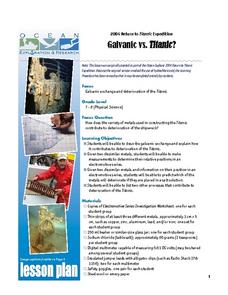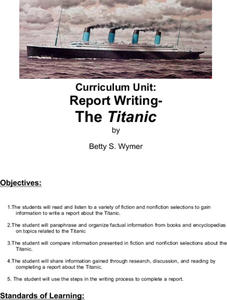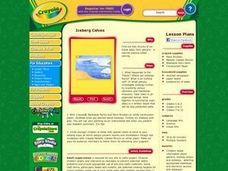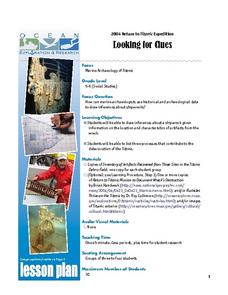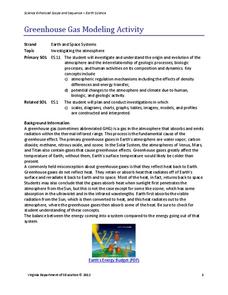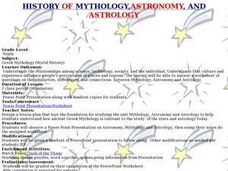Curated OER
The Titanic Impact of Science
Discuss personal ideas about science and how a filmmaker can employ the arts to promote science. After reading an article, young scientists will discover how James Cameron is trying to interest people in the oceans. In groups, they will...
University of Colorado
Using Spectral Data to Explore Saturn and Titan
Saturn's rings are made of dust, ice, and solid chunks of material. Individuals use spectrographs in this final installment of 22 lessons to determine the atmospheric elements. They analyze spectrums from Titan's atmosphere and...
University of Colorado
Using Spectral Data to Explore Saturn and Titan
Saturn is really far away, but knowledge of its composition is within reach. Future astronomers learn how scientists use spectra to remotely determine the chemical composition of a planet or moon. They try out this concept by analyzing...
Curated OER
What's Eating Titanic?
High schoolers, in groups, research the bio deterioration of the Titanic. They write a report focusing on the rusting of the Titanic and estimate the amount of time it will take for the Titanic's bow section to completely dissolve.
Curated OER
First Class First? Using Data to Explore the Tragedy of the Titanic
Students analyze and interpret data related to the crew and passengers of the Titanic. They research information on a Titanic database to illustrate specific statistical conclusions, and whether or not social status affected the outcome.
Curated OER
Galvanic vs. Titanic?
Students discover how galvanic exchange has contributed tot he deterioration of the Titanic. They perform an experiment in which they predict which of 2 metals deteriorate when placed in a salt solution.
Curated OER
Morse Code and the Titanic
Learners review the story of the Titanic. In this science inventions lesson, students use what they learn about the Titanic to study electromagnets and the invention of the telegraph. Learners make electromagnets with batteries, wire,...
NOAA
Ocean Exploration
Where am I? The second installment of a 23-part NOAA Enrichment in Marine sciences and Oceanography (NEMO) program starts with pupils guessing the years in which major ocean exploration events took place. The lesson then focuses on how...
Curated OER
Children's Literature Across the Curriculum Ideas-Polar, The Titanic Bear
Students read Polar, The Titanic Bear by Daisy Corning Stone Spedden. They complete a variety of cross-curricular activities surrounding this true story of a toy bear that survived the sinking of the Titanic. Included are reading, art,...
Curated OER
The Titanic
Young scholars use various sources to compare and contrast information about the Titanic. In groups, they create a list of questions and use the internet to find the answers. They write a report with the new information and use their...
Curated OER
First Class First? Using Data to Explore the Tragedy of the Titanic
Students analyze and interpret data related to the crew and passengers of the Titanic. They draw conclusions to better explain the people who were lost or saved as a result of the disaster, and whether or not social status affected the...
Curated OER
Art: Iceberg Calves
Students in small groups, research icebergs, including where they are located and the sinking of the Titanic. In addition, they discover the process of calving. Then, using construction paper and paints, students draw and color pictures...
University of Colorado
Happy Landings: A Splash or a Splat?
Huygens spacecraft landed on Saturn's moon Titan in 2005, making it the farthest landing from Earth ever made by a spacecraft. In this hands-on activity, the 12th installment of 22, groups explore how density affects speed. To do this,...
National Geographic
Ocean Exploration
Dora, Dora, Dora, Dora, Dora! This may be your little ones' best guess as to what it's like to be an explorer! Give them a deeper understanding with this compact examination. A four-minute video introduces them to Robert Ballard,...
University of Colorado
Is There Life on Earth?
To find life on another planet, scientists look for gases (atmosphere), water, and temperatures that are not extreme. For this activity, groups of pupils become "Titan-ians," scientists who want to explore Earth for possible life forms....
Curated OER
Titanic: Looking for Clues
Students make inferences about a shipwreck based on the location of artifacts. They role play as marine archaeologists and list three processes that contribute to the deterioration of the Titanic.
Curated OER
Bigger, Faster, Stronger . . . Higher
Students analyze popular feelings and beliefs about two major disasters: the sinking of the Titanic (1912) and the explosion of the Space Shuttle Challenger (1986). They compile evidence, through research and interviews, about how much...
Curated OER
Discoveries of Titanic Proportions
Students analyze various statements on the moon. After reading an article, they discuss the findings about a new moon around Saturn. In groups, they re-create a press conference in which the new findings were released to the public. ...
Curated OER
Lost Liners Scavenger Hunt
Students practice research skills by scouring Internet for facts and information about the lost ocean liners Titanic, Lusitania, and Empress of Ireland.
Curated OER
Voyage to Titan
Learners go to the linked web page "The Nine Planets" to find facts about Titan. They list elements of the solar system and the five planets of the outer solar system. Students find their weight on each planet. Titan is selected from the...
Curated OER
Who Sunk the Titanic
Students discuss possible reasons for the Titanic sinking. They are split into small groups to research a historical figure involved in the sinking of the Titanic. They formulate a way to prove their characters guilt or innocence....
Curated OER
All About Titan and the Huygens Probe
Young scholars examine the characterisitics of Saturn's largest moon, Titan. They discuss what they think is on Titan and what the Huygens probe can tell them about the moon. They write a summary about the information they gathered...
Virginia Department of Education
Greenhouse Gas Modeling Activity
Why are greenhouse gases called greenhouse gases? Young Earth scientists learn about greenhouse gases though experimentation in the second installment of a 3-part series. They use lamps to model radiant energy as well...
Curated OER
History of Mythology, Astronomy and Astrology
Ninth graders examine the relationships of science and technology and how it influences people's perceptions of places. For this mythology and astronomy lesson students view a PowerPoint presentation and complete a...
